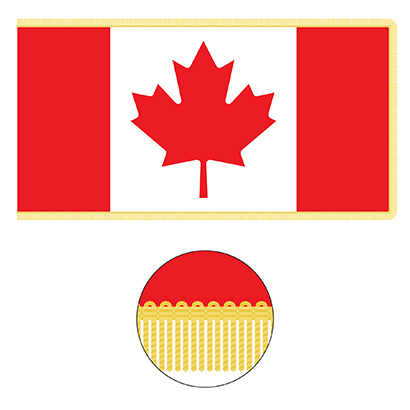Rules for flying the National Flag of Canada
The manner in which flags may be displayed in Canada is not governed by legislation but by established practice and convention. The etiquette outlined in this section is an adaptation of international usage and customs that the federal government has observed for many years. Given the important symbolism of flags, they should always be treated with respect.
The National Flag of Canada may be flown day and night and does not need to be lighted while flying after sundown.
On this page
- Displaying the National Flag
- Half-masting the flag
- Dipping the flag
- Breaking the flag
- Ceremonial dress flags
Displaying the National Flag
The National Flag must be flown at all federal government buildings, airports, as well as military bases and establishments within and outside Canada. It may be flown by night as well as by day.
Download a reference tool on displaying the National Flag of Canada.
Horizontally and vertically
When flown horizontally, the National Flag is flown with the maple leaf pointing upwards.
When hung vertically, the flag should be placed so that the upper part of the leaf points to the left, from the point of view of the observer facing the flag.
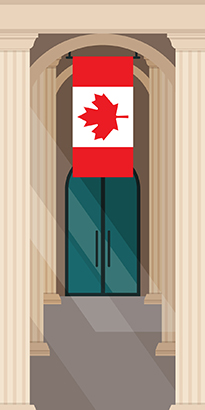
Did you know?
The canton, which is the most important position on a flag, should always be located in the top left, regardless of how the flag flies. That is why, when the National Flag of Canada is flown vertically, the maple leaf must point to the left, so that the canton remains in the upper left corner.
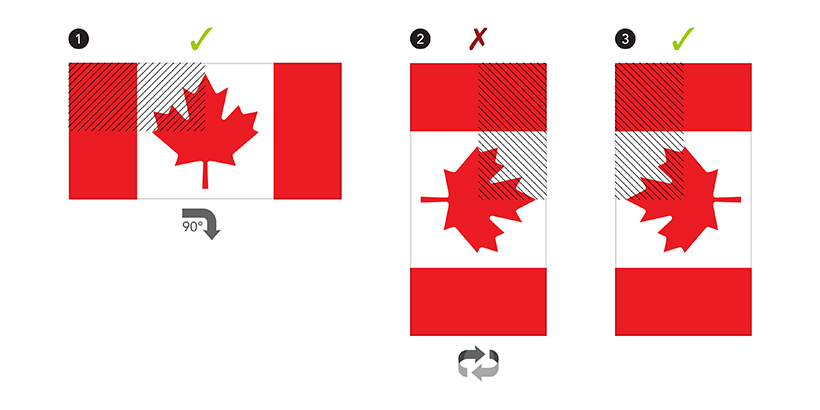
- When flying the National Flag horizontally with the pole to the left, the canton is in the proper position in the upper-left.
- When flying the flag vertically, if the flag is simply rotated a quarter-turn to the right from its horizontal position, so that the tip of the maple leaf points to the right, the canton ends up in the wrong position (upper-right). This does not respect the position of honour of the canton.
- Flipping the flag along its vertical axis returns the canton to the proper position in the upper-left. The observer sees the “reverse” of the flag, but the canton has been restored to the position of honour. The tip of the maple leaf is pointing left.
On a flagpole
The National Flag will always be flown on its own flagpole, with the sleeve nearest to the pole. The canton should be placed in the position nearest the top of the flagpole or mast. It is improper to fly the National Flag with another flag, of any type, on the same flagpole.
Flagpoles can be divided into three categories: exterior permanent poles (located outside of buildings, on top of a building or on the adjacent grounds), exterior portable poles and interior poles.
Exterior permanent poles should be fitted with a hoisting device such as a halyard and pulley arrangement to enable the flags to be easily raised, lowered and half-masted as required.
The length of the flagpole and the size of the flag for exterior permanent poles should correspond to the following dimensions:
| Flag | Pole |
|---|---|
| 0.90 X 1.80 metres | 5.10 to 6 metres |
| 3 X 6 feet | 17 to 20 feet |
| 1.40 X 2.80 metres | 9 to 10.50 metres |
| 4 1/2 X 9 feet | 30 to 35 feet |
| 1.80 X 3.60 metres | 12 to 13.50 metres |
| 6 X 12 feet | 40 to 45 feet |
| 2.30 X 4.60 metres | 15 metres |
| 7 1/2 X 15 feet | 50 feet |
It is also possible to add a yardarm or a gaff to a simple flagpole in order to display a greater number of flags. This practice is frequently used by naval establishments located on land, and is inspired by the display of flags and colours onboard ships. It is important to follow proper flag display etiquette when using a flagpole equipped in this manner.
Flag spreaders
When a flag is displayed on an interior flagpole, it will not be seen flying, but rather hanging from the pole. There are commercially-available devices that help to spread out a hanging flag to improve its appearance when displayed on an interior pole. These devices are not required for the display of interior flags, and thus their use is entirely optional. They have no effect on the protocol of flag display.
Flagpole finials
A finial is a device attached to the top of a flagpole.
When a flag is displayed indoors, on a flagpole, the pole should be topped by a finial. It can be in the form of a sphere/ball, a maple leaf, an acorn or a spear point. The National Flag of Canada and the flags of the Canadian provinces and territories, and those of the Governor General, Lieutenant Governors and Territorial Commissioners can be affixed to poles bearing any of these types of finials.
When displaying foreign flags on interior poles, they should be mounted on poles with a spear point or acorn finial rather than a maple leaf finial. For displays that combine both the Canadian flag and foreign flags, it is preferable that all poles have the same finial. It is not appropriate to fly the flag of a sovereign nation or state from a flagpole bearing a maple leaf finial.
Outdoor flagpoles typically have a ball-shaped finial. This is to prevent the flag from becoming tangled at the top of the pole during strong updrafts of wind. The staffs on His Majesty’s Canadian Ships bear a large painted finial in the shape of the Royal Crown – a naval tradition observed throughout The King’s Realms.
The use of a three-dimensional gold Crown or the Crest of the Coat of Arms of Canada (a crowned lion holding a maple leaf) is reserved for the colours of military regiments.
A number of organizations have their own unique finials that are specific to their organizational flags. Notably, Scouts Canada uses a version of its fleur-de-lys emblem, and St. John Ambulance uses a Maltese Cross. Poles bearing these types of finials should be reserved for the specific organizational flag.
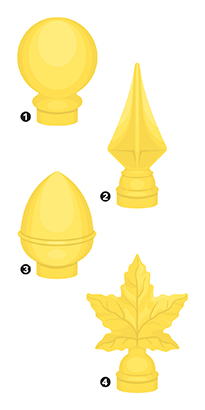
- Sphere or ball finial
- Spear point finial
- Acorn finial
- Maple Leaf finial
On a flag rope (halyard)
If flown on a flag rope (halyard), either horizontally or at an angle, the flag is flown in the same manner as on a flagpole. The canton should be raised as closely as possible to the top with the flag rope taut.
From a building
When displayed at an angle from a window or balcony, the flag is not considered to be hanging vertically and should be hung in the same way that it would be hung from a pole; with the sleeve nearest to the pole and the canton in the position nearest the top of the flagpole. The top point of the maple leaf should be pointing outward from the building, and its stem toward the building.
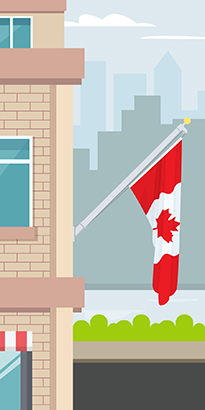
In an auditorium or place of worship
When the National Flag is displayed on a speaker’s platform, in a place of worship or auditorium, it should be against the wall or on a flagpole. If on a flagpole, it should be on the left from the point of view of the congregation or audience. If displayed flat against the wall, it should be above and behind the speaker.
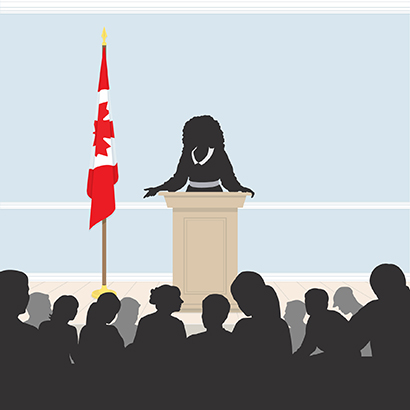
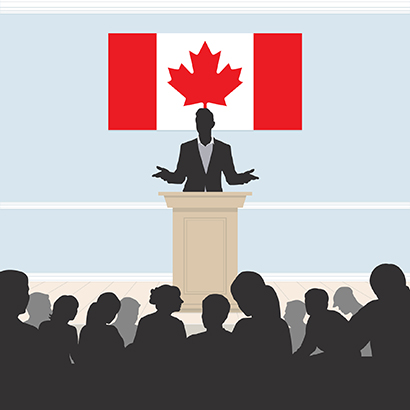
As a car Pennant
The place of honour for flying a car pennant is on the front right fender (passenger’s side). This is where the National Flag should be displayed when it is flown alone.
Displaying a distinguishing car pennant is not mandatory for a travelling dignitary. The circumstances determine whether or not it is suitable.
When the distinguishing flag of a dignitary is used as a car pennant – whether it be the National Flag used by the Prime Minister of Canada, a personal flag of a royal or vice-regal dignitary, or the national flag of a visiting foreign head of state – it does not have to be removed every time the dignitary gets in and out of the vehicle. The distinguishing flag should not, however, be flown on a moving vehicle when the dignitary is not present in the vehicle.
It should be noted that only the Prime Minister may use the National Flag of Canada as a distinguishing flag on a vehicle.

On ships and boats
The National Flag of Canada is the proper national colours for all Canadian ships and boats, including pleasure craft.
Foreign vessels may fly the Canadian Flag as a “courtesy flag” when they are berthed in a Canadian port. The flag then is customarily flown from the foremast (nearest the bow of the ship).
The general rules governing the use of the National Flag of Canada by merchant vessels and pleasure craft are as follows:
- The flag should be flown when entering and leaving a port or harbour, when anchored or moored in a port or harbour, and when sailing in Canadian territorial waters. It need not be flown while under way on the high seas unless the vessel wishes to identify its nationality to another ship;
- Whenever possible, the proper place for a vessel to display the national colours is at the stern. However, when at sea, the flag may be flown from a gaff on the foremast;
- A civilian vessel must hoist its flag if instructed to do so by any vessel under the command of the Canadian government or Canadian Armed Forces;
- When a merchant ship and a warship of any nationality pass or overtake one another, it is customary for the merchant ship to dip the flag as a gesture of courtesy. If on a staff or pole, the lowest corner of the flag should be brought to the level of the rail. If flown from a gaff, the flag should be lowered to six feet (1.80 m) above the level of the deck.
- The dipped flag remains lowered until the salute is acknowledged by the military vessel, by dipping its own flag in turn. A military vessel will not dip its flag unless first saluted by another vessel.
Note: It is important to distinguish “dipping” the flag in the nautical context, which is solely used as a salute between ships, from dipping (inclining) a flag carried on a pole or staff, which is used as a sign of respect in a ceremonial context. While the two practices are referred to by the same name, they are not related and have distinct functions and protocols.
The use of the National Flag on Canadian ships and boats is regulated by the Canada Shipping Act, section 64.
Did you know?
Historically, during naval warfare or acts of maritime piracy, enemy ships may have deceived their targets by flying the colours of allied nations before hoisting their proper identifying flags at the moment of attack. This may be the origin of the expression “to show one’s true colours,” meaning to reveal one’s true nature after misleading or deceiving behaviour.
Draping a casket
Being laid to rest with the flag is an honour that is not solely reserved for the funerals of soldiers, veterans and dignitaries; all Canadians are eligible. As the National Flag belongs to all Canadians, any Canadian may choose to have their casket draped with the flag.
The proper size of flag to drape a standard adult casket is 1.4 m x 2.8 m (4.5 feet x 9 feet). Depending on the circumstances, it may be necessary to secure the flag on the casket by means of a retaining band. Funeral homes can provide assistance with obtaining a properly sized flag and retaining band. Casket flags are specifically designed without a sleeve, toggle or halyard.
The flag should be removed and folded at a moment that is in accordance with the customs and wishes of the family. For example, this can be done indoors at the place of worship or the location where the final commemorative event is taking place, or outdoors as the remains are taken to the burial site or crematorium. In all cases, the flag should be removed before the casket is lowered into the grave, or before the remains are incinerated in a crematorium.
When draping a casket, the top of the leaf should point to the right and the stem to the left when observing from the foot of the casket.
Flowers or wreaths should be placed at the foot of the casket. For military, veterans, and law enforcement agencies, a headdress and a small black or red cushion displaying the deceased’s medals can be placed at the head of the casket. In accordance with traditions and customs, a sword or ceremonial belt can also be placed on the casket. Note that other groups or organizations may also adopt similar customs of display, and that non-military honours and decorations may also be displayed on a civilian casket.

Once a flag has been used to drape a casket, it should be properly folded according to the established flag-folding etiquette, and stored indoors in an appropriate place and manner. A flag box or presentation box may be used for this purpose. The flag should never again be flown.
The Canadian etiquette for flag folding, in the case of a funeral or committal service, calls for groups of either seven or nine people to fold the flag, with six or eight pallbearers and a head pallbearer to lead each group and provide instruction.
Note: These guidelines may be different from the traditions and practices of various groups or organizations. It is important to ensure that these traditions and, above all, the wishes of the deceased and the family are respected.
Half-masting the flag
Flags are half-masted as a sign of respect and to express a collective sense of sorrow during a time of national mourning. Given that national flags are recognized throughout the world as the ultimate symbols of their respective nations, the act of half-masting is a dramatic visual statement that speaks to the sense of loss that is shared by all their citizens.
Given the importance of the symbol of half-masting, the Government of Canada adopted the Rules for half-masting the National Flag of Canada to ensure a consistent approach to half-masting the National Flag at all federal buildings and installations. Similar rules are adopted by provinces, territories, municipalities and other organizations within their own jurisdictions.
Learn about half-masting and flag etiquette in times of mourning.
Dipping the flag
Dipping the flag refers to the practice of lowering or inclining a flag toward the ground as a sign of respect in a ceremonial context, when the flag is carried by flag bearers on portable poles or staffs. When dipping, flag bearers (who carry their flag so that it flies horizontally) lower their flagstaffs forward at a 45 degree angle. In addition, flags can be further lowered until they touch the ground.
In Canada’s official ceremonial protocol, dipping is exclusively a military practice. Specifically, Colours are dipped during a parade to salute the Sovereign or Head of State. There is no other official context in Canada in which dipping is required or customary.
In all other ceremonial contexts, when salutes are given, the flags are not dipped but are let fly. The flag bearer extends his/her hand and lets the flag fly free (releases the flag). At the conclusion of the salute, the flags are gathered in. This procedure applies during an inspection or on march past.
The National Flag, when carried, is never dipped or lowered to the ground. There is no occasion during which the National Flag is dipped.
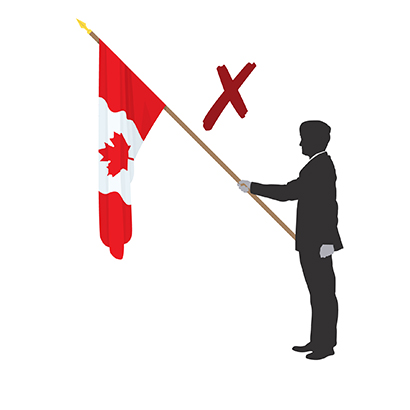
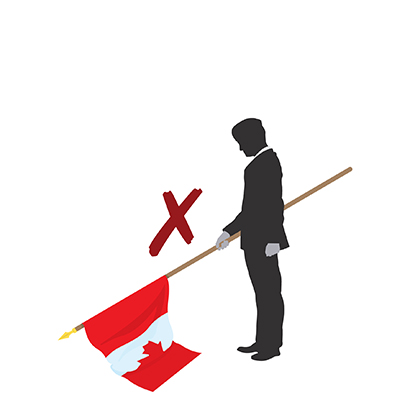
If a private organization wishes to dip its organizational flag(s) according to its own internal ceremonial protocol, it may do so using the protocols above as a guideline and ensuring that it respects the directive whereby the National Flag of Canada is never dipped.
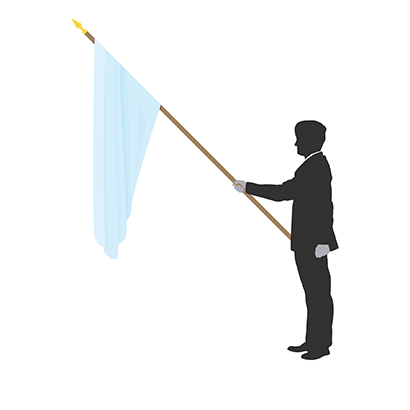
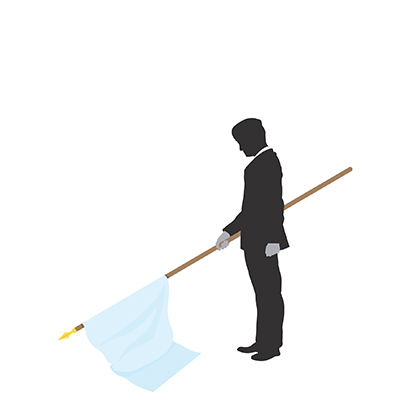
At sea, dipping may also refer to the practice of lowering and raising a ship’s flag in salute. For more information, see the section On ships and boats.
Breaking the flag
Breaking the flag refers to a ceremonial practice whereby a flag is quickly unfurled to mark the arrival of a distinguished person during a parade or ceremony. The distinguishing flag is folded, rolled and secured with a string in such a way that a sharp tug on the string will allow it to fly freely at the appropriate moment. This is usually, but not exclusively, done in a military ceremonial context.
Preparing the flag for breaking
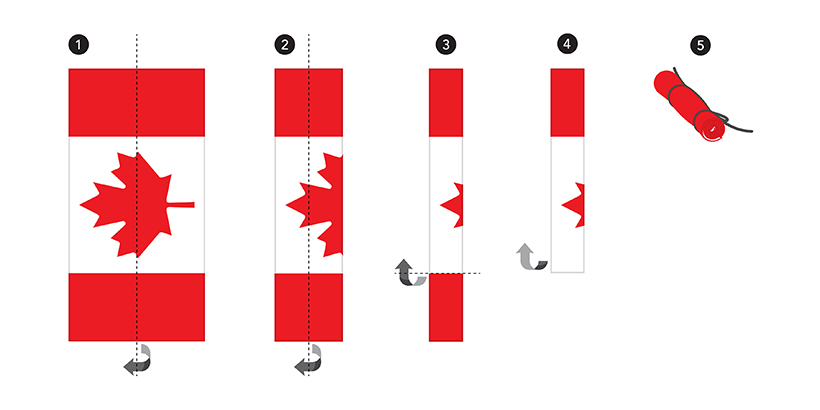
- The flag is folded in half along its long axis. The bottom of the flag (to the right in this image) is folded under.
- The flag is once again folded in half along its long axis. The lower part of the flag (to the right in this image) is folded under.
- A quarter of the length of the flag (on the bottom in this image) is folded under.
- Roll the flag.
- Tie with lightweight cotton string or its equivalent
Ceremonial dress flags
Ceremonial dress flags can be easily distinguished by the gold fringe around the edges. From a historical and legal standpoint, the fringe on a flag has no significance or symbolism. The fringe is, and always has been, a purely decorative addition.
A flag can have a fringe at the time of purchase or the fringe can be added later on. In the manufacturing of a ceremonial flag, the size of the flag is never altered. A gold fringe is simply sewn to the perimeter of the existing flag.
A fringe is frequently used on military flags and in formal settings such as parades, public meetings and entrances to government offices.
Ceremonial dress flags are never flown from an exterior flagpole. When using a ceremonial dress flag in a group of flags, all flags should be of the ceremonial type. It is not appropriate to mix ceremonial flags (with a fringe) with those without such a fringe. Consistency in display should be maintained.
